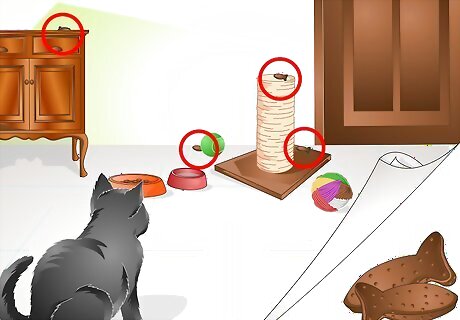
views
Making a Kitten-Friendly Room

Start your kitten off in a single room. After being at a shelter or even just being moved, your kitten is going to be stressed. Pick a quiet room for her to be in when you bring her home. Doing so lets her establish territory over one area and get used to the new surroundings. If you have other animals, make sure to keep them out of this room while your kitten is acclimating.

Pick a space with hiding spots. Your kitten will be nervous, and nervous kittens like to hide. Have safe spaces available where she can hide. For instance, you can make a simple hiding place by placing a sheet over a chair; leave a small opening at the bottom of the sheet so your kitten can enter the space. You can also provide cardboard boxes. However, do not have spaces where your kitten can be completely away from you, such as under the bed, as it will take her longer to acclimate.

Keep her in the room for a couple of days. You don't want to lock your kitten up forever. However, a couple of days in this quiet room will help her become acquainted with you and your house without being overwhelmed by your whole house at once.

Put out food and water. Make sure to have food and water available in the room. Don't forget that kittens need special food while they're growing. Look for food specifically marked for kittens when choosing one. If you have other pets, try placing her food near the door. On the other side of the door, put your other pets' food. That way, they start smelling each other, and they associate an enjoyable activity with the smell. Also, remember to include a litter box in the area, as well.

Include some fun. Have a few toys in the room for your kitten to play with. It's also good to provide a place to scratch, such as a post or carpet. Put out a blanket or cat bed where your kitten can sleep.

Hide some treats around the room. Put out some kitten treats around the room in various places. This process will encourage your kitten to walk around the room, as she'll be drawn to the smell.

Keep humans out, except for visiting. You want your cat to feel like she is able to establish her territory. If people in your house are living in the space, she may not feel like it's hers. Keep everyone out except to go in and visit the cat.

Visit the kitten. If you're kitten won't come out, don't force her. Just spend time in the room, talking out loud as you do so, which will help her adjust to the sound of your voice. Limit the visits to one or two people. If your kids want to visit, that's fine. However, only one kid should be allowed inside the room at once, and he should be supervised. Make sure he stays calm and isn't too loud while in the room. Too much noise can frighten the cat. If your kitten look like she wants to explore the rest of the household, she's likely getting acclimated to your home. Also, if she's starting to seem less scared, such as coming up and rubbing on you, that's another sign she's getting acclimated.
Showing You and Your Family Are Trustworthy

Keep to a regular feeding schedule. Your kitten will learn to recognize that you bring food, which helps earn her trust. Most cats have a finely honed sense of when meal time is, so try to be on time with food.

Sit with your cat while she eats. Once your cat seems fine with eating, sit in the room with her during mealtime. Don't make noise or try to approach her. Just sit off to the side. Also, don't try to touch her while she eats, as she may perceive that as a threat.

Let the cat approach you. The kitten will likely be interested in you. If she comes up to you, hold out your hand to let her smell you. If she doesn't run, try petting her softly on the head and back.

Encourage interaction. Try putting something a cat would like on your finger, encouraging her to come up and lick it. For instance, you could try chicken and gravy baby food or bit of canned cat food. She'll likely come up to you, and she'll pair the happy taste of the food with being around you.

Include other family members. Don't forget to include other family members in the introduction process. Have them sit with the kitten, too, encouraging interaction. However, don't overwhelm the kitten. Make sure only one or two people are in the room at the same time.

Don't force interaction. If your cat is not ready to come and meet you, don't drag her out. Let her come out in her own time. Don't try to pick her up or chase her down, as that will only terrify her more.

Use a toy to entice all your pets. That is, use a toy that will go under the door. Let both your old and new pets play with it at once. That will introduce new smells and get them to (hopefully) play together.

Trade pet scents. Take the bedding of one cat or pet, and switch it out with your new kitten. That way, they can continue to smell each other. You can also just gently rub a towel on each pet, then place it where the other pet can smell it.
Moving in to the Rest of the House

Limit access. It's best to only allow your cat to explore one new room at a time. If possible, only give her access to one new room a day by shutting doors. Another option is to provide your cat with supervised visits to the rest of the house, returning her to her enclosed space afterwards.

Let your pets trade rooms. While your new kitten is exploring a new room, let your other pets explore her room. This practice also encourages them to get used to each others' scents.

Crack open the door. Use a door stop to allow enough space so your pets can see each other. However, don't leave enough space that they can crawl through.

Put a litter box in its permanent location. Once your cat starts exploring, put out a new litter box where you want it to go permanently. However, don't take away the first one for a few weeks. Another way to change the location is to slowly move it towards it's new location. That is, shift it's position toward it's new location a foot a day. If you don't shift it gradually, your cat may try to go back to the old spot and use the bathroom where there isn't a litter box.

Give her free reign of the house. Once your cat has become accustomed to most of the house, let her have free reign of the house. Don't forget to cat proof your home to remove any hazards that can pose a danger to your cat.

Break up any fights or aggression. Once your new kitten has free reign, she may run into aggression with your other pets. If you see growling or spitting or if one of your animals looks like it is going to attack, break up the fight by clapping your hands loudly. You can also try using a spray bottle with water to distract the cats or throw a pillow near them. If they need a calming down period, separate them out again, then try again the next day.















Comments
0 comment